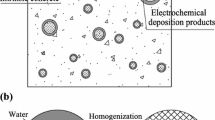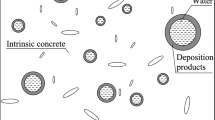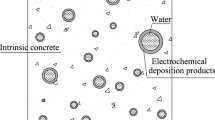Abstract
Most concrete structures repaired by the electrochemical deposition method (EDM) are not fully saturated in reality. Based on our latest work, a differential-scheme-based micromechanical framework is presented to predict the properties of unsaturated concrete repaired by the EDM. The equivalent matrix is reached by the micromechanical homogenization to the two-phase composite composed by the intrinsic concrete and unsaturated pores with different shapes. According to the multiphase micromechanical healing model which we presented recently, the three different states of the healing process in the saturated zone of the unsaturated concrete, including no healing, partial healing and complete healing, are quantitatively investigated by modifying the differential-scheme and the generalized self-consistent method with the obtained equivalent matrix. Modification procedures are utilized to rationalize the differential-scheme-based estimations for the repaired concrete in the dry state. Furthermore, predictions herein are compared with those of the existing models and available experimental results, thus illustrating the feasibility and capability of the proposed micromechanical framework. It is found that the predictions in this extension correspond to the experimental data better than those of our recent work.
Similar content being viewed by others
References
Yokoda, M., Fukute, T.: Rehabilitation and protection of marine concrete structure using electrodeposition method. In: Proceedings of the International RILEM/CSIRO/ACRA Conference on Rehabilitation of Concrete Structures, RILEM, Melbourne, pp. 213–222 (1992)
Sasaki, H., Yokoda M.: Repair method of marine reinforced concrete by electro deposition technique. In: Proceedings of the Annual Conference of Japanese Concrete Institute, pp. 849–854 (1992)
Jiang, Z.W., Li, W.T., Yuan, Z.C.: Influence of mineral additives and environmental conditions on the self-healing capabilities of cementitious materials. Cem. Concr. Compos. 57, 116–127 (2015)
Otsuki, N., Hisada, M., Ryu, J.S., Banshoya, E.J.: Rehabilition of concrete cracks by electrodeposition. Concr. Int. 21, 58–62 (1999)
Otsuki, N., Ryu, J.S.: Use of electrodeposition for repair of concrete with shrinkage cracks. J. Mater. Civil Eng. 13, 136–142 (2001)
Ryu, J.S., Otsuki, N.: Crack closure of reinforced concrete by electro deposition technique. Cem. Concr. Res. 32, 159–264 (2002)
Ryu, J.S.: New waterproofing technique for leaking concrete. J. Mater. Sci. Lett. 22, 1023–1025 (2003)
Ryu, J.S.: Influence of crack width, cover depth, water cement ratio and temperature on the formation of electrodeposition on the concrete surface. Mag. Concr. Res. 55, 35–40 (2003)
Ryu, J.S., Otsuki, N.: Experimental study on repair of concrete structural members by electrochemical method. Scr. Mater. 52, 1123–1127 (2005)
Jiang, L.H., Chu, H.Q.: Influence of concrete parameters on electrodeposition effect. Adv. Sci. Technol. Water Resour. 25, 23–25 (2005)
Jiang, Z.W., Xing, F., Sun, Z.P., Wang, P.M.: Healing effectiveness of cracks rehabilitation in reinforced concrete using electrodeposition method. J. Wuhan Univ. Technol. 23, 917–922 (2008)
Chang, J.J., Yeih, W.C., Hsu, H.M., Huang, N.M.: Performance evaluation of using electrochemical deposition as a repair method for reinforced concrete beams. Struct. Longev. 1, 75–93 (2009)
Chu, H.Q., Jiang, L.H.: Correlation analysis between concrete parameters and electrodeposition effect based on grey theory. J. Wuhan Univ. Technol. 31, 22–26 (2009)
Chen, Q.: The stochastic micromechanical models of the multiphase materials and their applications for the concrete repaired by electrochemical deposition method. Ph.D. dissertation Tongji University, Shanghai (2014)
Zhu, H.H., Chen, Q., Yan, Z.G., Ju, J.W., Zhou, S.: Micromechanical model for saturated concrete repaired by electrochemical deposition method. Mater. Struct. 47, 1067–1082 (2014)
Persson, B.: Moisture in concrete subjected to different kinds of curing. Mater. Struct. 30, 533–544 (1997)
Chatterji, S.: An explanation for the unsaturated state of water stored concrete. Cem. Concr. Compos. 26, 75–79 (2004)
Jiang, Z.W., Li, W.T., Deng, Z.L., Yan, Z.G.: Experimental investigation of the factors affecting accuracy and resolution of the pore structure of cement-based materials by thermoporometry. J. Zhejiang Univ. Sci. 14, 720–730 (2013)
Jiang, Z.W., Sun, Z.P., Wang, P.M.: Internal relative humidity distribution in cement paste due to moisture diffusion and self-desiccation. Cem. Concr. Res. 36, 320–325 (2006)
Jiang, Z.W., Sun, Z.P., Wang, P.M.: Autogenous relative humidity change and autogenous shrinkage of high-performance cement pastes. Cem. Concr. Res. 35, 1539–1545 (2005)
Yan, Z.G., Chen, Q., Zhu, H.H., Ju, J.W., Zhou, S., Jiang, Z.W.: A multiphase micromechanical model for unsaturated concrete repaired by electrochemical deposition method. Int. J. Solids Struct. 50, 3875–3885 (2013)
Wang, H.L., Li, Q.B.: Prediction of elastic modulus and Poisson’s ratio for unsaturated concrete. Int. J. Solids Struct. 44, 1370–1379 (2007)
Chen, Q., Zhu, H.H., Yan, Z.G., Deng, T., Zhou, S.: Micro-scale description of the saturated concrete repaired by electrochemical deposition method based on Mori-Tanaka method. J. Build Struct. 36, 98–103 (2015)
Chen, Q., Zhu, H.H., Yan, Z.G., Ju, J.W., Deng, T., Zhou, S.: Micro-scale description of the saturated concrete repaired by electrochemical deposition method based on self-consistent method. Chin. J. Theor. Appl. Mech. 47, 367–371 (2015)
Berryman, J.G.: Long-wave propagation in composite elastic media II. Ellipsoidal inclusion. J. Acoust. Soc. Am. 68, 1820–1831 (1980)
Yaman, I.O., Hearn, N., Aktan, H.M.: Active and non-active porosity in concrete part I: experimental evidence. Mater Struct. 35(3), 102–109 (2002)
Qu, J., Cherkaoui, M.: Fundamentals of Micromechanics of Solids. Wiley, Hoboken (2006)
Mura, T.: Micromechanics of defects in solids. Kluwer Academic Pub, Dordrecht (1987)
Ju, J., Chen, T.M.: Micromechanics and effective moduli of elastic composites containing randomly dispersed ellipsoidal inhomogeneities. Acta Mech. 103, 103–121 (1994)
Ju, J., Chen, T.: Effective elastic moduli of two-phase composites containing randomly dispersed spherical inhomogeneities. Acta Mech. 103, 123–144 (1994)
Weng, G.: Some elastic properties of reinforced solids, with special reference to isotropic ones containing spherical inclusions. Int. J. Eng. Sci. 22, 845–856 (1984)
Weng, G.: The theoretical connection between Mori–Tanaka’s theory and the Hashin–Shtrikman–Walpole bounds. Int. J. Eng. Sci. 28, 1111–1120 (1990)
Norris, A.N.: A differential scheme for the effective modulus of composites. Mech. Mat. 4, 1–16 (1985)
McLaughlin, R.: A study of the differential scheme for composite materials. Int. J. Eng. Sci. 15, 237–244 (1977)
Li, G.Q., Zhao, Y., Pang, S.S.: Four-phase sphere modeling of effective bulk modulus of concrete. Cem. Concr. Res. 29, 839–845 (1999)
Nguyen, N.B., Giraud, A., Grgic, D.: A composite sphere assemblage model for porous oolitic rocks. Int. J. Rock Mech. Min. 48, 909–921 (2011)
Ju, J., Zhang, X.: Micromechanics and effective transverse elastic moduli of composites with randomly located aligned circular fibers. Int. J. Solids Struct. 35, 941–960 (1998)
Ju, J., Sun, L.: A novel formulation for the exterior-point Eshelby’s tensor of an ellipsoidal inclusion. J. Appl. Mech. 66, 570–574 (1999)
Ju, J., Sun, L.: Effective elastoplastic behavior of metal matrix composites containing randomly located aligned spheroidal inhomogeneities. Part I: micromechanics-based formulation. Int. J. Solids Struct. 38, 183–201 (2001)
Ju, J., Yanase, K.: Micromechanics and effective elastic moduli of particle-reinforced composites with near-field particle interactions. Acta Mech. 215, 135–153 (2010)
Ju, J., Yanase, K.: Micromechanical effective elastic moduli of continuous fiber-reinforced composites with near-field fiber interactions. Acta Mech. 216, 87–103 (2011)
Sun, L., Ju, J.: Effective elastoplastic behavior of metal matrix composites containing randomly located aligned spheroidal inhomogeneities. Part II: applications. Int. J. Solids Struct. 38, 203–225 (2001)
Sun, L., Ju, J.: Elastoplastic modeling of metal matrix composites containing randomly located and oriented spheroidal particles. J. Appl. mech. 71, 774–785 (2004)
Yanase, K., Ju, J.W.: Effective elastic moduli of spherical particle reinforced composites containing imperfect interfaces. Int. J. Damage Mech. 21, 97–127 (2012)
Zhu, H.H., Chen, Q., Ju, J.W., Yan, Z.G., Guo, F., Wang, Y.Q., Jiang, Z.W., Zhou, S., Wu, B.: Maximum entropy based stochastic micromechanical model for two-phase composite considering the inter-particle interaction effect. Acta Mech. 226, 3069–3084 (2015)
Chen, Q., Zhu, H.H., Ju, J.W., Guo, F., Wang, L.B., Yan, Z.G., Deng, T., Zhou, S.: A stochastic micromechanical model for multiphase composite containing spherical inhomogeneities. Acta Mech. 226, 1861–1880 (2015)
Mousavi Nezhad, M., Zhu, H.H., Ju, J.W., Chen, Q.: A simplified multiscale damage model for the transversely isotropic shale rocks under tensile loading. Int. J. Damage Mech. 25(5), 705–726 (2016)
Chen, Q., Mousavi Nezhad, M., Fisher, Q., Zhu, H.H.: Multi-scale approach for modeling the transversely isotropic elastic properties of shale considering multi-inclusions and interfacial transition zone. Int. J. Rock Mech. Min. 84, 95–104 (2016)
Hashin, Z.: The elastic moduli of heterogeneous materials. J. Appl. Mech. 29, 143–150 (1962)
Christensen, R.M., Lo, K.H.: Solutions for effective shear properties in three phase sphere and cylinder models. J. Mech. Phys. Solids 27, 315–330 (1979)
Cohen, L., Ishai, O.: The elastic properties of three-phase composites. J. Compos. Mater. 1, 390–403 (1967)
Smith, J.C.: Experimental values for the elastic constants of a particulate-filled glassy polymer. J. Res. NBS 80A, 45–49 (1976)
Zhu, H.H., Zhou, S., Yan, Z.G., Ju, J.W., Chen, Q.: A two-dimensional micromechanical damage-healing model on microcrack-induced damage for microcapsule-enabled self-healing cementitious composites under tensile loading. Int. J. Damage Mech. 24, 95–115 (2015)
Author information
Authors and Affiliations
Corresponding author
Rights and permissions
About this article
Cite this article
Chen, Q., Jiang, Z., Yang, Z. et al. Differential-scheme based micromechanical framework for unsaturated concrete repaired by the electrochemical deposition method. Acta Mech 228, 415–431 (2017). https://doi.org/10.1007/s00707-016-1710-6
Received:
Revised:
Published:
Issue Date:
DOI: https://doi.org/10.1007/s00707-016-1710-6




